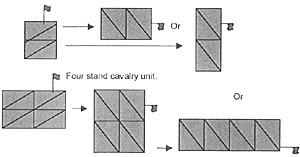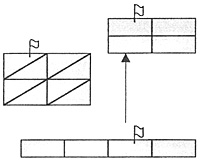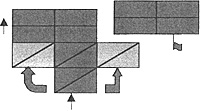First of all, it must be understood that when a group of men turn 90 degrees to face to their left or their right, the existing unit will change both its width and depth, depending upon how deep or wide it is before the turn takes place.
A rule of thumb I use is that if the infantry unit is one or two stands deep, it will be only one stand wide after it has turned. If the unit is three or four deep, it will be two stands wide after it has turned. If five or six stands deep, it will be three stands wide after it has turned. Cavalry are a bit more flexible as can be seen below.
Please check the diagrams for clarification. Also, it might be a good idea to copy these pages and insert them into your rule books both AW and MW!
![]() Examples of Infantry Facing
Examples of Infantry Facing
The infantry unit wishes to change its facing. It wishes to turn and face its right. It will end up in a column.
 Let's say the unit is larger, a nine stand unit of Scottish foot, three by three as below are in shieldwall. When this large unit turns, it falls out of shieldwall as it cannot maintain its formation and turn at the same time and will end up as follows.
Let's say the unit is larger, a nine stand unit of Scottish foot, three by three as below are in shieldwall. When this large unit turns, it falls out of shieldwall as it cannot maintain its formation and turn at the same time and will end up as follows.
 Examples of Cavalry Facing
Examples of Cavalry Facing
For mounted units, turns are a bit different. The cavalry unit in conrois wishes to turn. As it turns, it will must fall out of conrois while making a 90 degree turn and end up simply in line in either situation as below.
Cavalry units have a bit of flexibility in that they may end up either in a deep line or a two stand wide line after turning as shown.
 Dropping Back Stands
Dropping Back Stands
When a unit is about to run into another unit or delaying terrain while in the act of advancing, charging, counter-charging or retreating, it can drop back stands to avoid this. Basically, the troops will be falling back behind the rear ranks of the unit, making a deeper formation, but avoiding being disordered or worse by interpenetrating friends or getting stuck in delaying terrain.
The infantry unit drops back the three stands that would otherwise run into the impassable pond. This does not delay the unit any, only now it is in a long column instead of a three deep mass.
In this instance, the infantry unit wishes to move past its cavalry supports. It simply moves ahead and drops back
Stands in order to do so. There is no penalty for this and the unit gets to move its full allowance.
 Expanding Out
Expanding Out
When a unit has pushed back its opponents in a close combat, it may bring stands from its rear ranks forward in an expansion during the follow up move. One stand per flank may be brought forward. This will not be allowed if the expanding stands will contact another unit, either friendly or enemy.
The cavalry unit has pushed back the foot unit. Both move 1" in the direction of the arrows. The victorious cavalry unit may expand either to the right or to the left. If they expand to their right, they would be vulnerable to attack from the other enemy foot unit. The wiser choice would be to expand to the left.
Note that if the second foot unit had been closer, the cavalry would not have been able to expand to the right in any event, as they would have contacted the new unit and this is not allowed unless pursuing or breaking through.
Medieval Warfare Rules Clarifications
- Part 1. Turning Units, Dropping Back Stands and Expanding Out
Part 2: Cavalry and Infantry Wedges in Medieval Warfare
Part 3: Pursuits -- Rules Change
Part 4: Mantlets -- Rules Change
Part 5: Skirmish Targets and Frenzied Skirmish Infantry
Part 6: Turn Initiative
Part 7: Weapons Use -- Rules Change
Part 8: Roman Order Version 5.0 -- Rules Change for AW
Back to Saga # 95 Table of Contents
Back to Saga List of Issues
Back to MagWeb Master Magazine List
© Copyright 2004 by Terry Gore
This article appears in MagWeb.com (Magazine Web) on the Internet World Wide Web.
Other articles from military history and related magazines are available at http://www.magweb.com